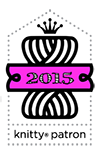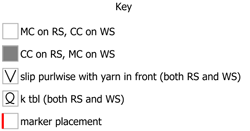Crystalline scarf, a free double-knitting pattern from Knitty.com. Free knitting pattern for a scarf using double knitting techniques and mathematical concepts.
INTRODUCTION
Crystalline
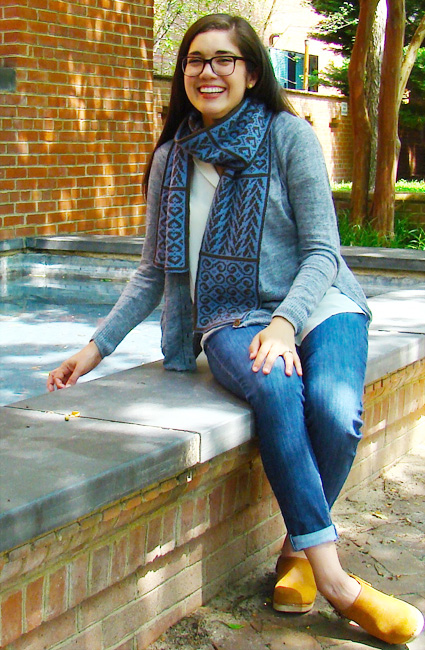 by Susan Goldstine
by Susan Goldstine
![]()
I like symmetry. Or, to be more precise, I like symmetries.
You see, I’m a mathematician, and mathematicians find patterns everywhere. We can’t help ourselves. We don’t just admire things that are symmetric, we ask questions about how they are symmetric. By a mirror reflection, like a face? By a rotation, like a pinwheel? By a translation (repetition in a straight line), like a row of toy soldiers? By a glide reflection, like footprints in the sand?
The mathematical artist Mary D. Shepherd demonstrated that in the craft of cross stitch, there are exactly twelve possible plane symmetry structures—that is, twelve fundamentally different arrangements of translations, rotations, reflections, and/or glide reflections that fill a flat plane with a repeating design. (Her explanation and accompanying artworks appear in Chapter 5 of Making Mathematics with Needlework: Ten Papers and Ten Projects, edited by sarah-marie belcastro and Carolyn Yackel.) Cross stitch conforms to a square grid, and three of these twelve symmetry types use the property that the square stitches are as tall as they are wide. This means that in a rectangular grid, like the grid formed by color work in knitting, only the remaining nine symmetry types are possible.
Armed with this mathematical framework, I set out to capture each of the nine symmetric structures with a harmonious set of designs in a double knit scarf. The result is Crystalline, so named because the symmetry types are nine of the seventeen plane crystallographic groups. (They are also called the wallpaper groups, but Wallpaper isn’t a particularly fetching pattern name.)
As a bonus, the sampler aspect of Crystalline makes it more fun to knit. On the one hand, you spend enough time with each design that the rhythm of the color pattern becomes easier as you go along. On the other hand, around the point where the current design becomes familiar enough to be boring, you’re off to a new color pattern. The combination of the extra layer of fabric in double knitting and the thin yarn and small needle make a scarf that is soft and super warm but still drapes beautifully, perfect for wrapping up as the weather turns chilly.
Editor's Note: You'll find this pattern translated into Danish here.
 model: Veronica Arellano Douglas
model: Veronica Arellano Douglas
 photos: Susan Goldstine
photos: Susan Goldstine
SIZE
One
FINISHED MEASUREMENTS
Width: 6.5 inches/16.5cm
Length: 67 inches/170cm
MATERIALS
Yarn
Lana Gatto VIP [80% extrafine merino, 20% cashmere; 216 yd/198 m per 50g skein]; color:
![]() [MC] Denim (10172); 3 skeins
[MC] Denim (10172); 3 skeins
![]() [CC] Chocolate (1262); 3 skeins
[CC] Chocolate (1262); 3 skeins
Recommended needle size
[always use a needle size that gives you the gauge listed below - every knitter's gauge is unique]
![]() 1 set US #2/2.75mm needles for working flat
1 set US #2/2.75mm needles for working flat
Notions
![]() wire stitch markers (see pattern notes)
wire stitch markers (see pattern notes)
![]() yarn needle
yarn needle
GAUGE
25 sts/38 rows = 4 inches/10 cm in st st
58 sts (29 squares on the chart)/36 rows = 4 inches/10cm in double knitting after blocking (see pattern notes)
PATTERN NOTES
[Knitty's list of standard abbreviations and techniques can be found here.]
This scarf uses double knitting, which makes two interlocking layers of fabric at once, both bearing the same two-color pattern but in opposite colors. All of the chart squares except the first and last in each row (as explained below) represent two stitches, a knit for the front color and a purl for the back color. Throughout the knitting process, you must always carry both yarns together so that they are either both in front of the work or both behind the work.
Note that the 58 stitches in the gauge indicator represent 29 squares on the double knitting chart.
Double Knitting Instructions (all chart stitches but the leftmost and rightmost)
For odd rows [RS]: On a white square, take both yarns to back and k1 in MC, then bring both yarns in front and p1 in CC. On a grey square, take both yarns to back and k1 in CC, then bring both yarns in front and p1 in MC.
For even rows [WS]: On a white square, take both yarns to back and k1 in CC, then bring both yarns in front and p1 in MC. On a grey square, take both yarns to back and k1 in MC, then bring both yarns in front and p1 in CC.
If you do this correctly, the design on the right side of the scarf will look like the chart, and the wrong side will have the colors reversed.
Selvedge Instructions (leftmost and rightmost chart stitches)
Unlike most double knitted designs, this scarf has a slip-stitch selvedge on either side of the double knitting for a cleaner edge. In all of the chart rows, the first and last squares each represent a single selvedge stitch. The first stitch in a chart row is always slipped with both yarns in front, and the last stitch is knit through the back loop using the CC on odd [RS] rows and the MC on even [WS] rows. In each case, the color you use for the final k tbl is the same color you knit within the border section that precedes it.
Using Stitch Markers
Stitch markers, while not essential, make the charted patterns significantly easier to work. Unfortunately, the most common kind of plastic stitch markers are too thick relative to the gauge of the scarf, and using them will force gaps between the stitches on either side. If you do not have thinner, wire stitch markers, you can create makeshift stitch markers by tying bits of thin scrap yarn into loops and placing them on your needles.
Symmetry Groups
For those who are curious, here is a brief description of the wallpaper group of symmetries for each of the nine patterns. These have no effect on the knitting process, and are listed here merely as a point of interest. If you would like to learn more about how these symmetries work, a good place to start reading is Science U’s web page about symmetries.
CMM: translations, 180° rotations, reflections, glide reflections; there are centers of rotation that lie on reflection axes.
PGG: translations, 180° rotations, glide reflections.
PM: translations, reflections.
P1: translations.
CM: translations, reflections, glide reflections.
PMG: translations, 180° rotations, reflections, glide reflections; there are no centers of rotation that lie on reflection axes.
P2: translations, 180° rotations.
PG: translations, glide reflections.
PMM: translations, 180° rotations, reflections.
CHARTS
DIRECTIONS
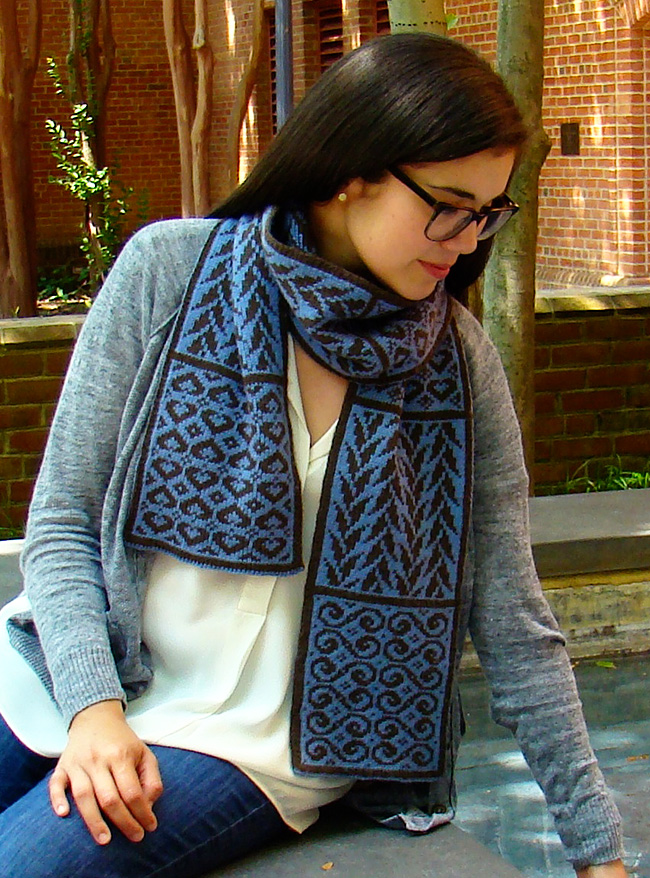
Using MC and the long-tail method, CO 7 sts, pm, [CO 20 sts, pm] 3 times, CO 22 sts, pm, CO 7 sts. 96 sts.
Setup Row [WS]: K1 tbl CC, [k1 MC, p1 CC] until 1 st remains, k1 tbl MC.
Charted Patterns
See Pattern Notes for how to work the slip-stitch selvedge.
Chart 1:
Work rows 1-23, work rows 4-23 twice more, work rows 24-28.
Chart 2:
Work rows 1-11, work rows 2-11 five more times, work rows 12-16.
Chart 3:
Work rows 1-11, work rows 2-11 five more times, work rows 12-16.
Chart 4:
Work rows 1-11, work rows 2-11 five more times, work rows 12-16.
Chart 5:
Work rows 1-11, work rows 2-11 five more times, work rows 12-16.
Chart 6:
Work rows 1-11, work rows 2-11 five more times, work rows 12-16.
Chart 7:
Work rows 1-11, work rows 2-11 five more times, work rows 12-16.
Chart 8:
Work rows 1-11, work rows 2-11 five more times, work rows 12-16.
Chart 9:
Work rows 1-21, work rows 2-21 twice more, work rows 22-26.
Cut CC and continue in MC.
Final row [RS]: Sl1 wyif, [k1, p1] until 1 st remains, k1 tbl.
Bind off in 1x1 ribbing pattern.
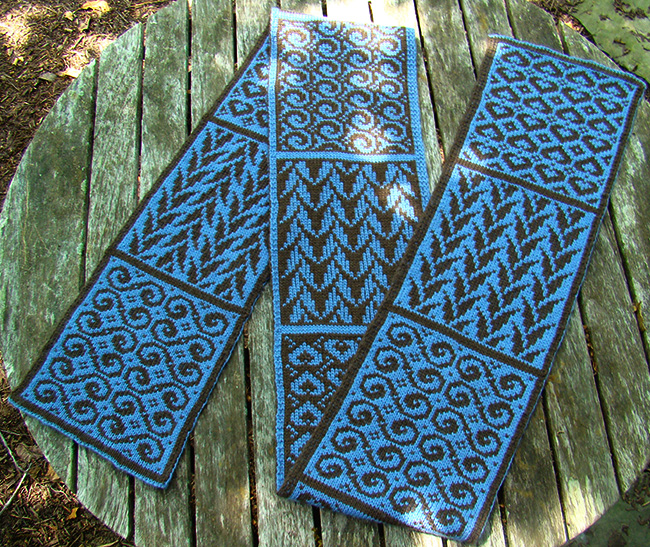
FINISHING
Weave the ends into the space between the two layers of fabric. Wet block.
ABOUT THE DESIGNER
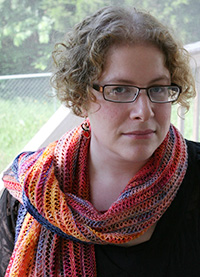 Susan Goldstine is a mathematics professor at St. Mary’s College of Maryland specializing in mathematics and the arts. While she has more experience as a bead crochet designer than a knitwear designer, she is notorious in her knitting circle for reengineering almost every pattern she knits.
Susan Goldstine is a mathematics professor at St. Mary’s College of Maryland specializing in mathematics and the arts. While she has more experience as a bead crochet designer than a knitwear designer, she is notorious in her knitting circle for reengineering almost every pattern she knits.
She is coauthor, along with Ellie Baker, of the book Crafting Conundrums: Puzzles and Patterns for the Bead Crochet Artist.
Pattern & images © 2016 Susan Goldstine. Contact Susan




